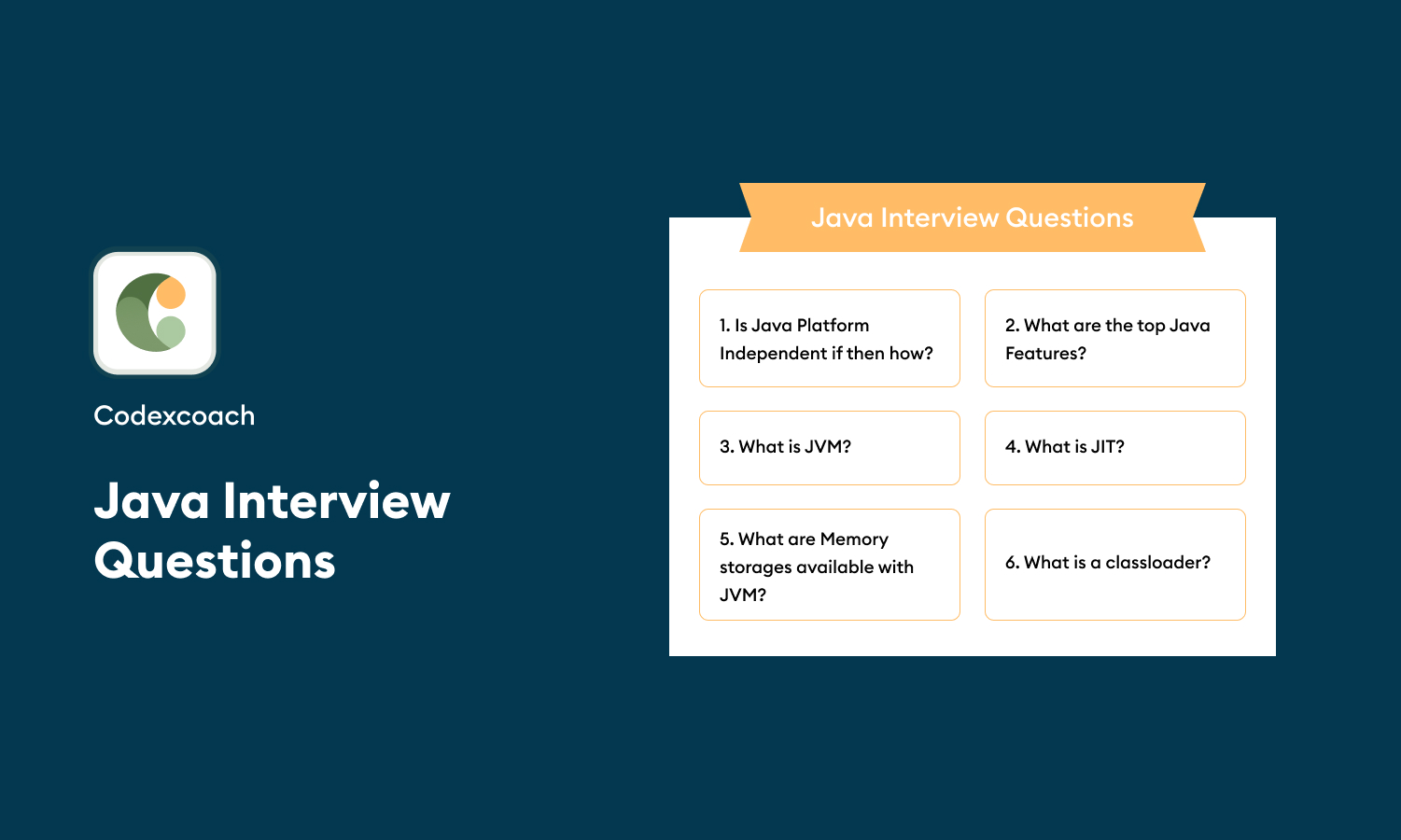Is Java platform-independent? How?
Yes, Java is a platform-independent language. This is because the Java compiler converts the source code into bytecode, which can be executed by any Java Virtual Machine (JVM), regardless of the underlying hardware and operating system.

What is Java?
Java is a high-level, object-oriented, robust, and secure programming language that is platform-independent and portable. Developed by James Gosling at Sun Microsystems (which is now a subsidiary of Oracle Corporation) in 1991, Java is designed for high performance, with a strong emphasis on runtime safety and multithreading.

Can you list the features of the Java programming language?
- The core features of Java include object-oriented structure, high performance, robustness, security, multithreading capabilities, architectural neutrality (platform independence), and portability. Java is also known for its extensive library support.

What is the Java Virtual Machine (JVM)?
- The JVM is a part of the Java Runtime Environment (JRE) that provides a runtime environment for executing Java bytecode. It is the component of the Java platform that makes Java a platform-independent language by enabling Java bytecode to be executed on any system that has the JVM installed.

Describe the Spring framework.
- The Spring framework is a comprehensive tool for supporting the development of Java applications. It provides an extensive programming and configuration model for modern Java-based enterprise applications. Its core features include dependency injection (IoC), aspect-oriented programming, and transaction management, among others. Spring is designed to work with any Java application and is widely used for building scalable, robust, and maintainable systems.

How do you reverse a string in Java?
- In Java, you can reverse a string by using a StringBuilder or StringBuffer class and calling the reverse() method. Java does not have a built-in reverse method for the String class due to the immutable nature of strings.

Explain JDK, JRE, and JVM.
- JDK stands for Java Development Kit and is a software development environment used for developing Java applications. It includes the JRE and development tools. The JRE, or Java Runtime Environment, is the installation package that provides the environment to run Java applications and applets. It includes the JVM, libraries, and other components to run applications written in Java. The JVM, as mentioned earlier, is the Java Virtual Machine, which actually executes Java bytecode.

What is the public static void main(String[] args) in Java?
- This method is the entry point for any Java application. public denotes that this method can be accessed from anywhere, static allows the method to be called without an instance, void means it does not return any value, and String[] args is an array of String objects that accepts arguments passed to the application during runtime.

What is a class loader in Java?
- The classLoader in Java is a part of the Java Runtime Environment that dynamically loads Java classes into the JVM. Java applications aren’t a single block of code but are composed of many individual classes. ClassLoaders load these classes when required, typically the ones not part of the Java core API.

How is Java different from C++?
- Java is purely object-oriented, meaning it doesn’t support global functions or variables outside of a class structure. It has a garbage collector for automatic memory management, whereas C++ requires manual memory management. Java also has a single inheritance model using interfaces, unlike C++ which allows for multiple inheritance. Java’s platform independence makes it distinct, as compiled Java code can run on all platforms that have a JVM, which is not the case with C++.

What are wrapper classes in Java?
- Wrapper classes in Java provide a way to use primitive data types (int, char, etc.) as objects. The primitive data type is wrapped in an object of its corresponding class, such as Integer for int, Character for char, and so on. Wrapper classes are used in Java classes that require an object as an argument, like in collections.

What is the difference between equals() and == in Java?
- In Java, == operator is used to compare primitives and check if two references point to the same object, not comparing the content inside the objects. The equals() method is intended to check the actual contents of an object for equality, rather than their references.

Explain exception handling in Java.
- Exception handling in Java is a robust mechanism that allows a program to deal with runtime errors without crashing. It’s done using four keywords: try, catch, finally, and throw. The try block encloses code that might throw an exception, while catch is used to handle the exception that occurs. finally contains code that must be executed whether an exception occurs or not, and throw is used to explicitly throw an exception.

What are Java Streams?
- Java Streams represent a sequence of elements on which one or more operations can be performed. Stream operations are either intermediate (returning a Stream) or terminal (returning a result or side-effect). They provide a high-level abstraction for Java collection manipulation, using functional-style operations.

What is the purpose of System.out.println() in Java?
- System.out.println() is used to print messages to the console. It is often used for debugging purposes, allowing developers to output text, variables, and other data types to the standard output stream, which is commonly the console or screen.

Explain generics in Java.
- Generics enable types (classes and interfaces) to be parameters when defining classes, interfaces, and methods. They provide a way to ensure type safety by making the code generic, so it can work with different data types while providing compile-time type checking.

What is multithreading in Java?
- Multithreading is a Java feature that allows concurrent execution of two or more parts of a program for maximum utilization of CPU. Each part of such a program is called a thread, and threads run in parallel within the process. Multithreading is used in Java to perform complicated tasks in a background thread without affecting the main thread’s performance.

Explain the concept of the Java Memory Model.
- The Java Memory Model specifies how the Java Virtual Machine works with the computer’s memory. It defines the interaction between threads and memory and ensures that shared variables are consistently updated across all threads.

What is a Java Package and how is it used?
- A Java package is a namespace that organizes a set of related classes and interfaces. Conceptually you can think of packages as being similar to different folders on your computer. They are used to avoid name conflicts and to control access, making it easier to locate and use classes, interfaces, enumerations, and annotations.

What is an abstract class?
- An abstract class in Java is a class that cannot be instantiated and is used to declare common characteristics for subclasses. It can contain abstract methods (without bodies) as well as concrete methods (with bodies). Abstract classes are used as a base for other classes to extend and implement the abstract methods.

Explain the concept of Constructors in Java.
- Constructors in Java are special methods that are called when an object is instantiated. They have the same name as the class and are used to set up initial values for object attributes.

What is the purpose of the final keyword in Java?
- In Java, the final keyword can be used to mark a variable as unchangeable (constant), a method as not overrideable, or a class as not inheritable.

Describe the Singleton pattern in Java.
- The Singleton pattern is a design pattern that ensures a class has only one instance and provides a global point of access to it. In Java, this can be implemented by making the constructor private, defining a static method that returns the instance, and ensuring that only one instance is created by controlling the instantiation logic.

What is the difference between Abstract Class and Interface in Java?
- Abstract classes can have both abstract and concrete methods, provide a base for subclasses, and can have constructors. Interfaces can only declare methods (before Java 8 all methods are public and abstract by default) and constants (public static final). With Java 8 and onwards, interfaces can also have default and static methods with a body.

How does Java achieve memory management?
- Java achieves memory management through its garbage collection, which automatically deallocates memory that is no longer in use or reachable by an application. This helps prevent memory leaks and other related problems.

What is synchronization in Java?
- Synchronization in Java is a mechanism that ensures that only one thread can access the resource at a time. It is used to prevent thread interference and memory consistency errors in multithreaded applications.

Explain method overloading and method overriding in Java.
- Method overloading occurs when multiple methods have the same name but different parameters (type or number). It is a compile-time polymorphism. Method overriding occurs when a subclass provides a specific implementation of a method that is already provided by its parent class or interface. It is a runtime polymorphism.

Can you explain the static keyword in Java?
- The static keyword in Java denotes that a member variable or method belongs to the class, rather than instances of the class. Static methods can be called without creating an object of the class, and static variables are shared among all instances of the class.

What are Java Annotations?
- Annotations in Java are used to provide metadata for Java code. They do not directly affect the operation of the code they annotate but can be used by the development tools and runtime libraries to generate code, XML files, and so forth.

What is a transient variable in Java?
- A transient variable is one that is not serialized during the serialization process. This keyword is used to indicate that a field should not be part of the serialization process and be ignored when objects are serialized and deserialized.





